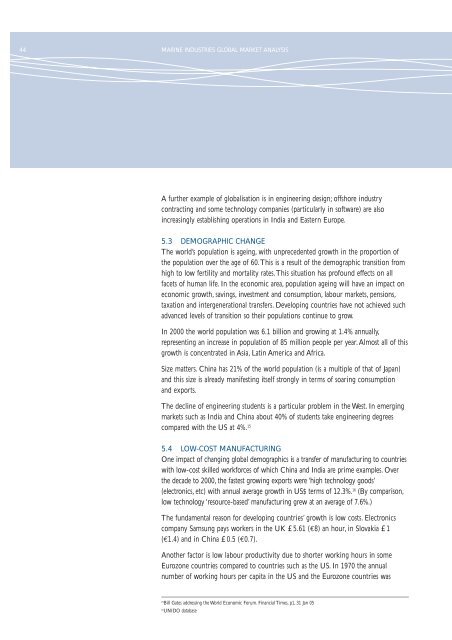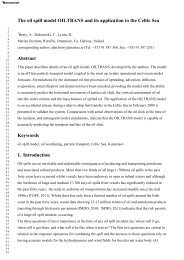Marine Industries Global Market Analysis - Marine Institute
Marine Industries Global Market Analysis - Marine Institute
Marine Industries Global Market Analysis - Marine Institute
You also want an ePaper? Increase the reach of your titles
YUMPU automatically turns print PDFs into web optimized ePapers that Google loves.
44 MARINE INDUSTRIES GLOBAL MARKET ANALYSIS<br />
A further example of globalisation is in engineering design; offshore industry<br />
contracting and some technology companies (particularly in software) are also<br />
increasingly establishing operations in India and Eastern Europe.<br />
5.3 DEMOGRAPHIC CHANGE<br />
The world’s population is ageing, with unprecedented growth in the proportion of<br />
the population over the age of 60.This is a result of the demographic transition from<br />
high to low fertility and mortality rates.This situation has profound effects on all<br />
facets of human life. In the economic area, population ageing will have an impact on<br />
economic growth, savings, investment and consumption, labour markets, pensions,<br />
taxation and intergenerational transfers. Developing countries have not achieved such<br />
advanced levels of transition so their populations continue to grow.<br />
In 2000 the world population was 6.1 billion and growing at 1.4% annually,<br />
representing an increase in population of 85 million people per year. Almost all of this<br />
growth is concentrated in Asia, Latin America and Africa.<br />
Size matters. China has 21% of the world population (is a multiple of that of Japan)<br />
and this size is already manifesting itself strongly in terms of soaring consumption<br />
and exports.<br />
The decline of engineering students is a particular problem in the West. In emerging<br />
markets such as India and China about 40% of students take engineering degrees<br />
compared with the US at 4%. 15<br />
5.4 LOW-COST MANUFACTURING<br />
One impact of changing global demographics is a transfer of manufacturing to countries<br />
with low-cost skilled workforces of which China and India are prime examples. Over<br />
the decade to 2000, the fastest growing exports were ‘high technology goods’<br />
(electronics, etc) with annual average growth in US$ terms of 12.3%. 16 (By comparison,<br />
low technology ‘resource-based’ manufacturing grew at an average of 7.6%.)<br />
The fundamental reason for developing countries’ growth is low costs. Electronics<br />
company Samsung pays workers in the UK £5.61 (€8) an hour, in Slovakia £1<br />
(€1.4) and in China £0.5 (€0.7).<br />
Another factor is low labour productivity due to shorter working hours in some<br />
Eurozone countries compared to countries such as the US. In 1970 the annual<br />
number of working hours per capita in the US and the Eurozone countries was<br />
15<br />
Bill Gates addressing the World Economic Forum. Financial Times, p1, 31 Jan 05<br />
16<br />
UNIDO database

















